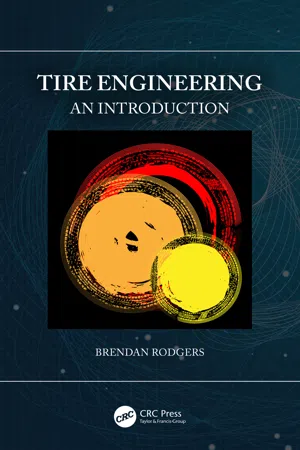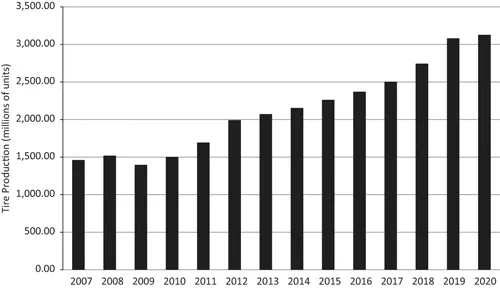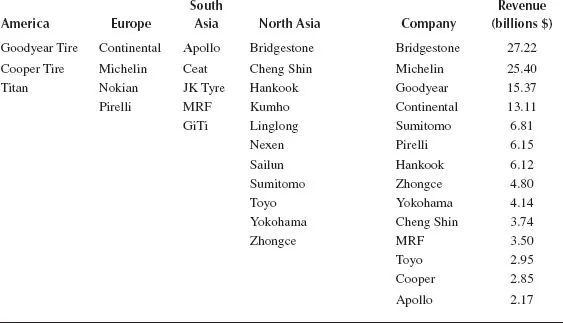
- 278 pages
- English
- ePUB (mobile friendly)
- Available on iOS & Android
eBook - ePub
About this book
The modern tire is the most complex, composite product in mass production. Yet given its complexity and required performance, there is little information in the public domain regarding its development. This book provides an introduction to tire design, construction, and manufacturing in the context of materials technologies used today, along with future trends and disrupting technologies.
- Focuses on design and construction
- Discusses the relationship between materials and performance
- Reviews tire uniformity as a key differentiator among manufacturers
- Evaluates design and construction features versus performance
Written for engineers in the polymer, industrial, chemical, mechanical, and automotive industries, this book offers a comprehensive view of tire design, including materials selection, construction, manufacturing, quality control, and future trends.
Frequently asked questions
Yes, you can cancel anytime from the Subscription tab in your account settings on the Perlego website. Your subscription will stay active until the end of your current billing period. Learn how to cancel your subscription.
At the moment all of our mobile-responsive ePub books are available to download via the app. Most of our PDFs are also available to download and we're working on making the final remaining ones downloadable now. Learn more here.
Perlego offers two plans: Essential and Complete
- Essential is ideal for learners and professionals who enjoy exploring a wide range of subjects. Access the Essential Library with 800,000+ trusted titles and best-sellers across business, personal growth, and the humanities. Includes unlimited reading time and Standard Read Aloud voice.
- Complete: Perfect for advanced learners and researchers needing full, unrestricted access. Unlock 1.4M+ books across hundreds of subjects, including academic and specialized titles. The Complete Plan also includes advanced features like Premium Read Aloud and Research Assistant.
We are an online textbook subscription service, where you can get access to an entire online library for less than the price of a single book per month. With over 1 million books across 1000+ topics, we’ve got you covered! Learn more here.
Look out for the read-aloud symbol on your next book to see if you can listen to it. The read-aloud tool reads text aloud for you, highlighting the text as it is being read. You can pause it, speed it up and slow it down. Learn more here.
Yes! You can use the Perlego app on both iOS or Android devices to read anytime, anywhere — even offline. Perfect for commutes or when you’re on the go.
Please note we cannot support devices running on iOS 13 and Android 7 or earlier. Learn more about using the app.
Please note we cannot support devices running on iOS 13 and Android 7 or earlier. Learn more about using the app.
Yes, you can access Tire Engineering by Brendan Rodgers in PDF and/or ePUB format, as well as other popular books in Technology & Engineering & Automotive Transportation & Engineering. We have over one million books available in our catalogue for you to explore.
Information
Edition
11 Introduction to Tire Engineering
1.1 Introduction to the Global Tire Industry
The global tire industry has shown remarkable growth, reflecting the growing global economy and the corresponding increase in standards of living. Discounting the impact of the pandemic due to COVID-19, in the year 2020, total global tire production had been expected to exceed three billion units. Though there is considerable variation in researcher’s estimates for both previous and future production, regardless of the source, the growth of the tire industry has been largely linear over time, with an anticipated minor dip in 2021 and 2022, and then a return to historic linear growth rates from 2023 onwards (1–3). Other than a dip in 2009, the raw materials supply base for the industry has shown similar growth rates and is expected to exceed $110 billion by 2024, illustrating the impact of the industry on global economic growth (4).
Geographically, most of the future industry growth will be in East and South-East Asia, and will be driven by a number of important factors, first of which is a strong desire for car ownership, despite car sharing and other inner-city demographic trends. Secondly, increasing transportation growth and efficiency will continue to drive the trucking industry and associated truck and bus tire demands. Thirdly, national economic policies will influence future investments in new capacity. Tire manufacturing is labor intensive, capital intensive, and requires a high level of skilled labor, thereby supporting governmental policies on employment. This point will be reviewed in Chapter 8, on tire manufacturing.
With regard to industry growth estimates, there is typically a high degree of variability in the industry reports (5, 6, ). This is due to many factors, such as the quality of the raw data being collected, what tires to include, and the proprietary nature of data tire companies are willing to release. This discussion on tire engineering and technology will focus on only the main line tires, which cover products for the consumer and commercial markets, i.e., racing, passenger car, light truck, commercial truck and bus, farm, heavy-duty off-road, and aircraft tires. Though much of the technology still applies, bicycle, motorcycle, and light utility applications are largely excluded (Figure 1.1).

Within the industry, there have been two core business trends, firstly, the merging or acquisition of manufacturing companies in North America and Europe, driven by the need for economy of scale, and secondly, the emergence of new companies in Asia. In China, the government has encouraged the merging of companies to achieve economy of scale, to improve quality, and to protect employment. For example, tire factories require a certain throughput rate to be economic, in the order of 20,000 to 25,000 passenger tires per day or 270 tons of products, depending on the tire types. The merging of smaller companies helps to facilitate more economic manufacturing output rates. Otherwise, manufacturing costs can undergo a rapid exponential increase as output drops, which has been one of the underlying reasons for the closing of many plants in traditional markets. Furthermore, the global market has evolved into essentially four regions, defined by the level of economic development and the quality of the transportation infrastructure. This is reflected in the number of tire manufacturing companies and the location of their headquarters (Table 1.1).
TABLE 1.1
Global Tire Manufacturing Participation and Revenues (7, 8, )
Global Tire Manufacturing Participation and Revenues (7, 8, )

The emergence of four distinct regions or markets is driven by consumer requirements, infrastructure, and the local or national regulatory environments. What is common between the regions is a similar manufacturing base, i.e., the same type of production equipment and the same global raw materials supply base. The differences are with respect to product design, construction, and the compound line-up of the materials to meet the market needs. Table 1.2 is a simplified snapshot of regional performance parameters that regulators and consumers consider in tire performance. Though parameters such as traction and vehicle stopping distances are important in all markets, some performance parameters will tend to receive more emphasis than others, depending on the market.
TABLE 1.2
Tire Demographic Trends and General Focus for Different Regions (5)
Tire Demographic Trends and General Focus for Different Regions (5)

Given the nature of the various markets, there are still many factors in tire technology in common, which are applicable to all markets, and this will now be covered. Five aspects of tire engineering and technology will be discussed: tire design, construction, materials technology, manufacturing, and end-product performance. There are many subsets to each of these five core areas. For example, in manufacturing, quality control and tire uniformity are of the utmost importance. Each tire manufacturer will have its proprietary procedures and processes to meet their product design requirements. This review will therefor...
Table of contents
- Cover
- Half-Title
- Title
- Copyright
- Contents
- Preface
- Author Biography
- Glossary
- Chapter 1 Introduction to Tire Engineering
- Chapter 2 Tire Tread Technology
- Chapter 3 Tire Casing Construction
- Chapter 4 Tire Innerliner
- Chapter 5 Tire Reinforcements
- Chapter 6 Radial Tire Materials Technology and Rubber Compounding
- Chapter 7 Radial Tire Compound Polymer Blends
- Chapter 8 Tire Manufacturing
- Chapter 9 Manufacturing Quality Control and Tire Uniformity
- Chapter 10 Tire Testing and Performance
- Chapter 11 Future Trends
- Appendix 1: Abbreviations for Tire Polymers and Polymer Additives
- Appendix 2: Recognized Industry Abbreviations for Accelerators
- Appendix 3: Common Terms for Compounding Ingredients
- Index